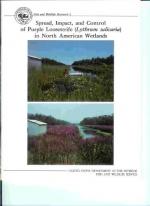|
This section contains 1,423 words (approx. 5 pages at 300 words per page) |

|
Lythrum Salicaria
Lythrum salicaria, commonly known as purple loosestrife, is an exotic, wetland perennial introduced from Europe approximately two-hundred years ago. The plant was introduced both as a contaminant of European ship ballast and as a valued medical herb (Malecki, Blossey, Hight & Schroeder, 1993). These plants although attractive to look at are responsible for the degradation of many New York wetlands. Because they produce so many seeds and can grow up to a centimeter a day, they are able to eliminate native plants and thus, reducing the food for the wetland inhabitants.
Characteristics
Purple loosestrife is approximately two meters tall with thirty to fifty stems forming wide-topped crowns. These reddish purple flower masses are so dense that they form a canopy. "Darwin noted that three types of flowers occurred on L. salaria plants and that three lengths of styles occurred with three combinations of anther lengths. He also noted...
|
This section contains 1,423 words (approx. 5 pages at 300 words per page) |

|


